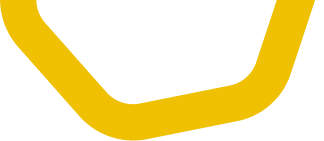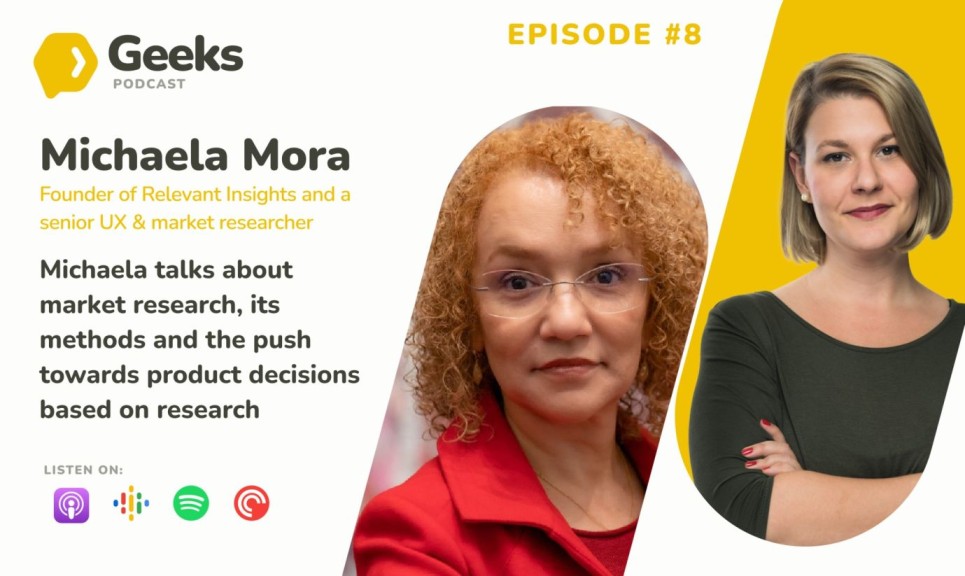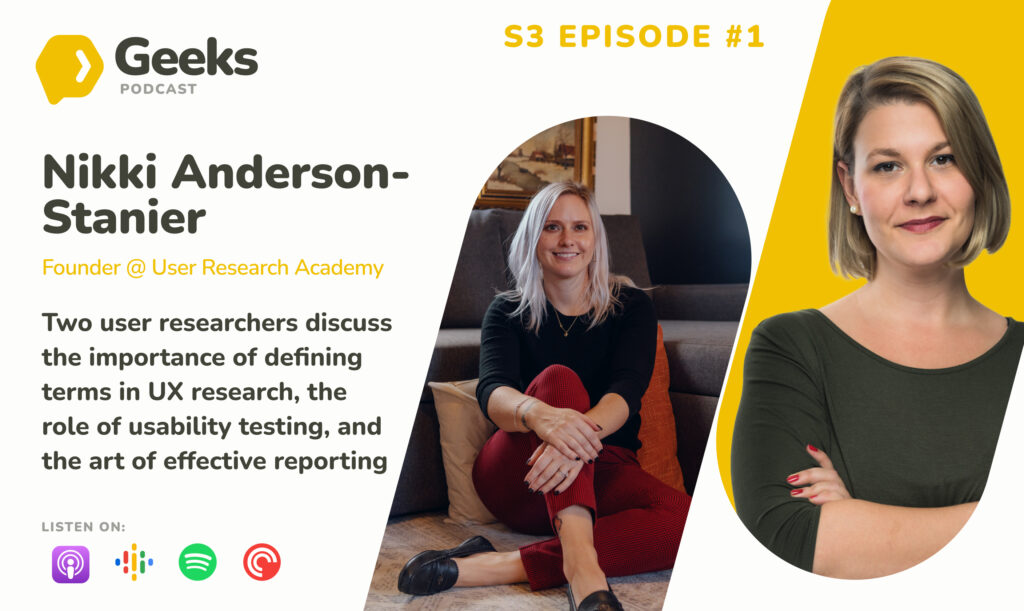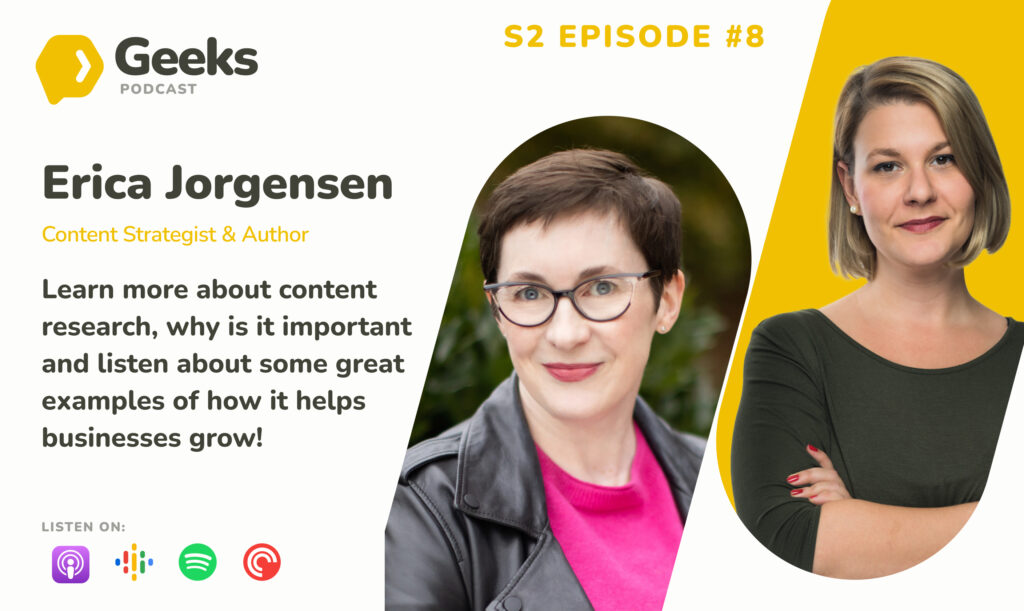Welcome to the second season of UX Research Geeks. In this episode, we are thrilled to introduce Sina Schreiber, a prominent figure in user research and content strategy. Tune in as Sina shares her journey in user research, its role in democratization, and the fascinating intersection with content strategy at Condens, offering valuable insights into the world of UX research professionals.
Episode highlights
00:02:09 – Sina’s Diverse Career Path
00:12:09 – Combining Content and Research
00:14:06 – Condens Benefits for Researchers
00:25:33 – Stay in Touch with Sina on LinkedIn
About our guest Sina Schreiber
Sina Schreiber is a UX Researcher and Content Strategist with a background in social media strategy, digital transformation, and graphic design. At Condens, she conducts user research with people who are UX Research professionals themselves. In her role, she incorporates the findings into product development as well as the content strategy focused on helpful guides, insights from experts in the field, templates, and more in the UX research space. To learn more, you can connect with her on LinkedIn.
Podcast transcript
[00:00:00] Tina Ličková:
Hello and welcome to UX Research Geeks. I’m your host Tina Ličková, a researcher and a strategist, and this podcast is brought to you by UXtweak, an all-in-one UX research tool.
Welcome to the new season of UX Research Geeks. This is the first episode with the one and only Sina Schreiber, who many of you might know from the research repository software Condens. We talked together about her path to user research and the role in democratization. We dived into the intersection of user research and the content strategy that she connects in her role in Condens.
Tune into her learnings from doing research with us, UXR professionals. Today we are here, Tina and Sina. Sina, you are pretty known to the research community. You are one of the people, the faces of Condens and also somebody who was mentioned in the research yearbook of user interviews, but what is important to tell about yourself these days?
Who are you?
[00:01:11] Sina Schreiber: Hi, Tina. Yeah, indeed. It’s Tina and Sina today. Yeah I’m a UX researcher and content strategist at Condens currently. And we are a software company and a tool for user research analysis and also research repositories in German, based in Germany. And in my role there, I have also the opportunity to create a lot of content and share it with the different UX research communities. And that’s why yeah, I’m in a lucky position to be connected with a lot of researchers as well.
[00:01:46] Tina Ličková: You have a very interesting word in Germany, which combines other words together, Werdegang I would say career flow. You started and you studied something, then you switched and then you came to content.
Can you maybe explain a little bit more about that? Because that’s a really interesting career flow as I translate it.
[00:02:09] Sina Schreiber: Sure. Yeah. It’s been a journey. Yeah. I studied communication science and international public relations and then had my first jobs in the field around communication or digital communication.
And it’s a broad field and there are so many opportunities and also like areas where you could specialize in. And I actually was a lot about trying stuff also, but trial and error learning what I like, what I don’t like, what I want to do. And somehow I ended up in a position where I was working on a global social media strategy for the Cultural Institute.
And I was part of a content management team and working with different people who created digital products as well for the website different apps and I learned more about the approaches of product or development, also content development, but it was like a new, like an interesting perspective for me to get there from that role. Also this is where I first discovered, having a user centered approach when you develop tools also – for example, I was working on an internal monitoring tool. This really helps and this really makes better products and this better for, yeah, for everyone, I would say.
So this is where I got interested in that area. And that’s why, when I moved more into that direction and had different stations after that as well. And at some point I noticed, okay, I really want to go into that user experience design area more. So I took a step back, took half a year off to focus on learning more about UX research and user experience design. Actually, it was not clear for me at the beginning that user research is something that I could see as a separate field here. For me, this was tied together, but then I learned, okay, this really makes a difference if you really focus on the research part as well.
And that’s why I wanted to have the next job, the next role I’m working in to be really a dedicated research role or have this research focus, because I think it’s great to focus on those fundamentals as well. Also, because I liked that part, I noticed that. And when I was looking for jobs, a lot of positions where: user experience designer, UX /UI designer combination, sometimes UI/ UX designer, which is also, which says something about how the discipline is seen and I could yeah, tell from like conversations or also even from job description that the research part is not valued the same in every role that has the term UX. So for me, I was really looking for something with the research focus to work on that side as well.
[00:04:41] Tina Ličková: And do I understand it right that you found this job at Condens right away or Did you have a job as a researcher before? How did it go?
[00:04:52] Sina Schreiber: I did not have a research job before but I had different roles where research was a part of my role. But yeah, during the half year I was learning about UX Design and user research, I got in contact with Condens and the team from Condens, and this was like a perfect fit because as I said, in the beginning, I’m doing a bit like a mix of user research and also creating content based on what we learn from the research. So it was a great mix for me to bring together also the communication and content I did before with the new area, I would say.
[00:05:25] Tina Ličková: Yeah. I want to explore the combination, but before that, I’m super interested because it’s like a little bit of an inception style. Like you are a researcher for a research company or for somebody who is building software for researchers. And I was not using Condens for a long time, but it’s like having these automated repositories or ones that offer a lot of possibilities. Your research in the company is a big game changer. There was code coding there – I don’t know, a hundred years, but still you took something out of the discipline and put it into a great software and you are a researcher for researchers. How does it feel? What’s the perks and what’s the downsides of it?
[00:06:10] Sina Schreiber: Yeah, it’s true. It sounds a bit meta, but that’s a big part of what I do because we are the user research analysis tool. And so our users are. Not all, but most of them are user researchers themselves.
Also other roads who do research from time to time. Also belong to the group of our users, but I do research and I’m so happy that I actually have to have the chance to do that. For me, it’s yeah, it’s a wonderful place to be in and to learn about the researchers and also about the field in general.
And I really love it. And. I would say I’m in a very lucky position because most researchers actually enjoy also being on the other side of the research table from time to time. In most cases, they are really happy to be invited to research studies and to share feedback, for example. So that’s really great.
And also the people I do research with – they tend to be very aware of the general, like product development process and everything around that, and also understand that different, like user requests have to be prioritized or fit into a bigger picture. The feedback is often, yeah, it’s very detailed and very friendly and also not too pushy.
So if we get feedback something like, I may be the only person that is in the need of ABC, but maybe you should check with other customers, but this is the case for me. So this is always like really I see that the people know what I’m doing and share feedback in a way that makes it easy for us actually.
[00:07:43] Tina Ličková: Okay. It’s interesting that we have empathy toward each other, probably as I understand it. You said you love it. What do you love about it? This is always like the nice part of geeking out. What do you love about research with researchers? You said something then maybe.
[00:07:58] Sina Schreiber: I said in the beginning that for me it was really also the discipline in general that I was interested in moving into years ago, and wanted to learn more about.
And now I have the chance to really learn about a lot of the like facets of it. For example, I have the chance to get to know like the perspective views and challenges of researchers in like different settings, working like from freelance researchers to like small, smaller research teams that were embedded in different product teams, also with researchers who work in a setting that is more like an in house agency, I would say.
So to really get into the details here for me, like I find it super interesting too. To have the chance to explore all more about those different areas. That’s really great, I would say.
[00:08:45] Tina Ličková: And you said a very interesting thing before that. I’m also like thinking since I started in research or UX in general, that the research part in UX, probably not and when you speak to your counterparts, the researchers, how, this is something that I’m interested because I’m, I was a one research team in my previous job and most of the time I was not in research teams in other projects as well. How did the researchers feel when it comes to evaluation of their work?
[00:09:20] Sina Schreiber: Yeah, that’s an interesting question. So what I noticed from like my From the interviews I do or the conversations I have, what I definitely see is like the growth of the discipline. There’s barely any case where a researcher’s working in one setting since I don’t know, a few years and nothing changed, either they are the first ones or like they were the first ones and now have a team or they’re working with different people who conduct research from time to time in a setting.
So there’s a lot of stuff happening and like the discipline is growing, which you can also probably tell by a lot of things like open positions or new positions in that field. So I think that in general shows that the value of user research is growing and in companies, people start to see, yeah, definitely the value of the whole discipline of focusing on the users and generally bringing a user centered approach to the wider organizations.
So that’s definitely one development that I noticed, but of course it depends on the stage of maturity of UX research in the different organizations. So besides the general direction, there are definitely people who have to communicate the insights or the value of research a lot in the roles and have to focus on maybe the promotion of the discipline, I would say a lot besides actually conducting research and analyzing data. There’s like a huge part where they focus on, okay, how can we work together with the organization with different teams, different partners who are not familiar, maybe don’t know user research or like the potential value of including researchers or research approaches in their work and focus on that side as well. That’s still like a huge part of some of the, of, for many of the researchers I, I speak with. Yeah.
[00:11:13] Tina Ličková: That’s why I wanted to talk about democratization because there, it’s like this big trend world. Word right now in the business and everybody hates it and loves it. And it’s a big thing and we have to somehow figure out what to do about it on one hand. On the other hand, it’s really interesting to hear exactly your perspective of somebody who is helping researchers to communicate and to scale up their research or even the research ops management.
How does content management help you with that? And I liked the combination that you are really thinking about the research and what could be communicated and thinking about the research or what, how you can help them. And I valued many times your it was more, it was not a research thing, but a feedback like I gave you and you were like, Oh, but you can find it here and you can do it this way.
And it really helped me. So how content management thing, I call it a thing, falls into this?
[00:12:09] Sina Schreiber: In general, it’s a good idea to give also like other people in the organization who are not researchers, basic training or like introduction to the field, or also like in involving them in terms of inviting them to join a research session as an observer or something like that, because I think this can be have a really positive impact on what the organization in general can, can learn and take from those kinds of conversations. And also can be a key element of you as a researcher conveying the value of research. I think, actually, I think there’s a big overlap between the approaches of content and user research.
When you look at both disciplines and I try to like from the conversations I have, maybe doing like research studies, dedicated studies, or also like when we had conversations in the past general, like feedback, and then we try to really have a conversation to learn more about the context of where the question is coming from to also transfer that to the general question of- okay, what is, how can we help here?
And this is not, sometimes this leads into recommendations or like ideas that I can discuss with the team about improving the product. But that’s not always the case. Sometimes there’s like other resources helpful or maybe even better. In terms of planning explaining different use cases or settings or different options.
As one example, I like the whole thing about help center guides and stuff like that, how to guide. But also in terms of preparing like resources, materials to support researchers to for example explain what is a research repository to like colleagues who are not familiar with the whole idea of that or what to use a research discipline general to think beyond, okay, what can we do inside the product, but like around it as well.
[00:14:06] Tina Ličková: And now you mentioned a really interesting thing. What is the value? Because I remember when we were discussing at work Oh, okay, there’s this thing – Condens and I were proposing we will go and buy a plan. And multiple times I had to like, answer the question what is it for and what is it good for?
What would be your short pitch to somebody – what is it good for for researchers to have something like condense?
[00:14:33] Sina Schreiber: Yeah, like in the first place, I would like to learn more about the situation of the researcher, because I think this can be different. I think one part could be around the analysis side where we can support with different features that can, for example, at one point speed up the work of a researcher by features like offering or generating automated transcripts, for example.
But also helping the researcher to focus on the work that can be not done by a tool or automated because they have more time for that to actually dive deeper into the data. So this is like the one area I would say, like, where a tool like Condens can really help, and if it’s more about building. Building a database or like a research repository and like a central place for UX research, also there are different sides to that. I would say this really can improve the work of a researcher, for example, because there’s a platform. A starting point that collects the information that is in most of the cases already there.
But it’s people having conversations with users or customers and getting feedback and like having a platform that helps you to centralize that can really improve the quality of work and also of your research because you can make use of the knowledge that is there and then focus research studies on the gaps that you identify on the areas that you, where you see that you don’t know enough about that yet. So this really can bring the research to the next level and also helps the researchers work with taking away a lot of like administrative stuff that is filling up the calendars of most of the Researchers like I speak with have not been working with such a tool, for example, by making it very easy to see who they have contacted in a research study last, or when was the last contact with one participant?
What data do we have about one participant? How long can we store that? Having a central place for that and one single point can really make the administrative part less cumbersome, I would say. And have the researcher to focus on other parts of the research and really the sense making part.
[00:16:45] Tina Ličková: This brings me back to the value because as researchers, we are, and this is what I hear in the business, we are struggling a little bit with showing the value. The business is growing. The field on the other side, business people are sometimes like, but what is it good for? It’s a lot of work we have to put into communicating the insights, making sure they are impacting products.
And. It also brings me to the idea that in the democratization or scaling up, however you call it, the tools, the infrastructure are immensely important, not only for researchers, but also for other colleagues. But if you, if there, if we will lose the link between tools and researchers, how would you say?
Do these tools and the right infrastructure impact the product and the business directly?
[00:17:38] Sina Schreiber: So okay, so we took, like we spoke about the part of the streamer and the researchers work, but besides that, I think a good infrastructure can also like in a setting where you work with people who, for example, conduct research from time to time only, or that work with research insights only from time to time or start to get into that area. Infrastructure can also help you as a researcher in terms of it’s a place, it’s a chance for you to provide a good structure, templates, legal forms, stuff like that. And also to also like inexperienced people who do research because that is the case in some of the organizations by a tool and creating the right setting for that. That’s also like one thing, but having all that in like a central platform, I think can be a good way to, to also like a mentor and guide, also give feedback on people who conduct research from time to time only.
There’s this dimension and I think in general, like having this platform supporting you to work close with transcript or recordings or like raw data in general can also be helpful in terms of really not losing the original meaning of the data you found, because when you have a structure that supports you to include the raw data and not switch between tools and summarizing it again until the personal meaning gets lost.
This really can have a big impact, I would say, on the quality of the findings, because it’s easier to really work with what you find and not lose it on the way somehow.
[00:19:09] Tina Ličková: Because you are an insider talking to researchers, talking knowing about their needs and knowing about what they would probably need also in the future.
Is there anything okay, this is going to be a trend in the next month, maybe years. This is what we need to be prepared for as researchers.
[00:19:28] Sina Schreiber: So there’s definitely this part, which I find very exciting, of being in a group growing discipline. So we also like, I think a tool or repository or platform or whatever can help you during the next stages that the discipline is growing.
So there are people coming into the research world and teams are growing. And I think there’s also – it’s an important topic to how we can make sure to have the knowledge that is there and available for new joiners, people who come into a new team to be accessible so that they can learn about the user research that has already been conducted. And what about the general knowledge that is there? So I think this is also like one, one thing to think of maybe earlier than until somebody is coming, but how can a platform or structure can support you here to make it easy to onboard new team members as well.
And also when different people work together to, for some parts, it’s important to think about, okay, how can we make this consistent? For example adding contextual information to research data. If you’re in a team of one, maybe it makes no difference, but as soon as like people are coming in, it would be great to also be able to make use of what you’ve done before and make that accessible and not have to duplicate studies, because just because like information is not findable anymore or something like that.
So that’s definitely like one area where I think this is becoming more and more important.
[00:21:06] Tina Ličková: Looking at what we have at UX tweak in the data on how the business is growing in different parts of the world there is for sure okay, the US is the market leader. There is a lot more work for researchers than we have in Europe, probably.
But it’s also different in Europe. Do you see, or what are the differences between, when it comes to using tools or research needs, research department setups? Different areas of the world where you have your clients and what would you say are the biggest differences?
[00:21:44] Sina Schreiber: I would not really say that it’s geographical differences, but definitely that’s true.
So like we’re speaking about growing teams. But it’s not everywhere the case, of course, there are like solo researchers and I’m doing all the stuff on their own. But also say that like the growth of the discipline comes into the topic again, because maybe it’s not about growing the team, but growing the role of user research or the impact or scaling in that area that I think is happening also in maybe where you are the like only researcher because you’re working with different other teams.
I think in that area, it’s important to think about offering an easy way to share user research evidence or like the reports of findings across organizations and maybe giving, thinking about giving access to research data in the level of depth they need. So if it’s, if you’re working with not just not researchers, but others, then it’s maybe more about thinking, okay, how can we share like on the highest level, maybe the research data, but to really, to have an impact as well, even if you’re working in a small team.
[00:22:54] Tina Ličková: Final question, Sina, because again, I’m amazed by the fact that you are researching with researchers. It’s basically like doing an MBA in research. I think for you, you can learn and I think you are learning a lot when it comes to the craft, what would you say are your biggest learnings from the last month or maybe years from this field.
[00:23:18] Sina Schreiber: What I really learned, like I, I have this combination of content strategy and user research in my role, but what I discovered that it’s actually, there is this, the big, a bigger overlap than I expected it to be honest, because researchers have to think a lot about like content creation or the communication part as well. So how can we make a report engaging and interesting? How can we communicate findings in a way that people want to learn more and want to take action based on that. So that’s definitely something that I realized the overlap is bigger than I expected it to be.
And I really like to see the parallel structures here as well. Okay. So we have this overlap, which I. Learn more and more about where I think both disciplines can learn from each other as well using similar approaches and focusing on understanding target audiences or users or the people who are better first and then taking action based on what you learned here.
So it’s definitely one thing. Also what I hear in many conversations is That recruiting in general is really a pain point for a lot of people who do, or like a lot of researchers, so I definitely, even though like I’m in the lucky position of people generally are open to, to join sessions and interested in participating in studies I could learn from some tips about recruiting and for example, making sure to have some extra sessions scheduled and to be in a safe set here as well. And then that one thing I learned, we touched on the topic in our conversation already, is that for many UX researchers, I think a big part of the job besides conducting primary research or secondary research is really about the communication, finding partners across an organization to have an impact besides actually conducting the research. What I learned is that this is like a huge part, even sometimes even 50/50 to not just carry out, carry on the research, but really think about, okay, how can this work in this organization or in the setting I’m in?
So that takes a really big part.
[00:25:26] Tina Ličková: Great. Sina if anybody wants to follow you, not in the creepy way, just follow your work. Where can people do it?
[00:25:33] Sina Schreiber: So I’m on LinkedIn. And I’m happy to connect there. I also, we as Condens share posts and new content pieces and also announce different UX research related events on our LinkedIn channel as well.
So that’s one opportunity, one, one possibility to stay in touch. And besides that, we also have a mailing list, for example from where we, once a month, we share a guide on UX research meetups and events happening in the next month. And also including new content pieces that I was working on, for example but also from other team members from time to time.
Based on what we learned from the conversations with researchers and what we think might be helpful to contribute or how we can contribute to the community.
[00:26:26] Tina Ličková: Thank you, Sina. Thank you for your time and thank you for speaking to us.
[00:26:29] Sina Schreiber: Thank you so much for the invitation.
[00:26:32] Tina Ličková: Thank you for listening to UX Research Geeks.
If you like this episode, don’t forget to share it with your friends. Leave a review on your favorite podcast platform and subscribe to stay updated when a new episode comes out.
💡 This podcast was brought to you by UXtweak, an all-in-one UX research software.
















